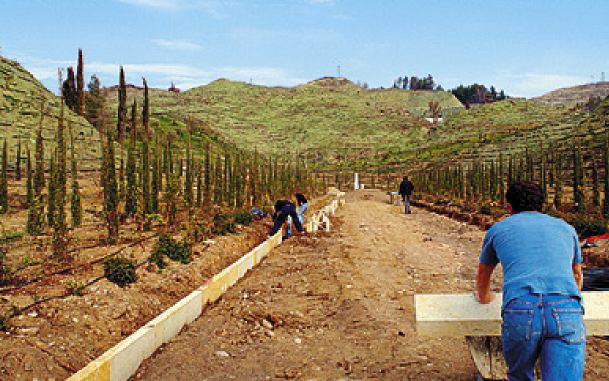 |
||
|
Olympia Goes Back to its Roots Destroyed by last summer's wildfires, Olympia's forestland has been given a makeover based on its ancient foliage JENNIFER GAY |
||
|
The fires that all but consumed Ancient Olympia a year ago were central to last summer's tragic loss of forestland. Firefighters were left struggling to keep the flames from reaching the 2,800-year-old UNESCO World Heritage site, symbolic for many Greeks as the embodiment of the values embraced by the cradle of civilisation. Few believed the forests surrounding the site could burn because the high-power sprinkler system in place around the perimeter should have slowed the progress of the flames. In the event, power failures meant the system did not operate, and the backup generators failed to kick in. Though the ancient monuments were saved, the fire scorched the museum courtyard and destroyed the forests of the Hill of Kronos as well as other surrounding woodland. |
 The approach to the Pierre de Coubertin monument in Ancient Olympia showing the planting of young Cypresses and the introduction of soil-retention works on steeper hillsides |
|
Ironically, the flame-lighting ceremony for the Beijing Olympics Games held in March this year gave the authorities a big incentive to waste no time in planning the regeneration of the forests. Work began almost immediately to stabilise the soil before the winter rains, and throughout September and October 2007, large trunks of burnt trees were set horizontally on the Hill of Kronos to prevent loss of soil during rainfall. After initial quotations from international contractors to plant big trees at enormous cost were rejected, the Ministry of Culture asked experienced forester George Karetzos of the Forestry Research Institute to mastermind the planting scheme. He understood that it made far more sense both ecologically and economically to plant small trees and shrubs. Though of course the initial impact is less, the long-term prognosis for healthy establishment is much better. Young plants are quickly able to put down roots and, once a good anchorage system is in place, top growth is rapid. A newly-planted large tree hardly grows at all in the early years. After five years plus of pot culture, it is heavily dependent on huge quantities of water just to keep it alive. Once in the soil, it can take years for the roots to break out and develop sufficiently to support crown growth. Meanwhile, smaller plants, finding it easier to adapt to their new situation, soon overtake the more mature plantings. Five years down the line, it's clear to see that investment in big trees is best left for only the most prominent positions. For example, by an entrance, where impact really counts. Destined to burn? While researching what to plant, Karetzos had the benefit of access to accurate records of over 200 species found growing around Olympia in 2001. The area was designated as a Natura 2000 site and, as such, underwent a full botanical survey at that time. Despite the diversity of the records, the dominant species before the fire was pine, an over-used, fire-adapted species that is virtually doomed to burn periodically, especially with today's increased risks of fire. Some question whether trees and shrubs should simply be allowed to regenerate after fire rather than going to the expense of replanting. However, in the case of Olympia, Karetzos realised that replanting offered the opportunity to move away from pine-dominance and reintroduce species that would have been growing around Olympia in ancient times. He carefully researched descriptions of the area by Pausanius, traveller and geographer (2nd century AD) and Theophrastus, often referred to as the father of modern botany (371-287 BC). He found that the species growing around Olympia 2,000 years ago were far less flammable, with oaks being predominant. Pining for a makeover Taking into consideration the ecology and history of the area, Karetzos came up with an approach that encouraged regeneration alongside replanting, but discouraged dominance of pine through selective thinning. Not surprisingly, oaks make up 30 percent of the planting mix, including Valonia Oak (Quercus macrolepis), Downy Oak (Quercus pubescens), Kermes or Shrubby Oak (Quercus coccifera), and Holm Oak (Quercus ilex). Other species include natives such as Cypress (Cupressus sempervirens), Judas tree (Cercis siliquastrum), Turpentine Tree (Pistacia terebinthus), White poplar (Populus alba), Ash (Fraxinus ornus), Mastic (Pistacia lentiscus), Bay (Laurus nobilis), Strawberry tree (Arbutus unedo), Myrtle (Myrtus communis), Mediterranean Buckthorn (Rhamnus alaternus), and Spanish Broom (Spartium junceum). The John S Latsis Public Benefit Foundation has covered the cost of the replanting. So far 30,000 trees and shrubs have been replanted at a cost of 1.5 million euros, with an additional 1.5 million euros available for further replanting and maintenance around Ancient Olympia over the next four years. Plants will receive around 20 litres of water every 15-20 days for the first two years. This approach of harnessing nature but reintroducing species present in the ancient site seems not only appropriate but sustainable. A silver lining to that smoke-filled cloud? |
||
|
|
||
(Posting Date 28 November 2008) HCS readers can view other excellent articles by this writer in the News & Issues and other sections of our extensive, permanent archives at the URL http://www.helleniccomserve.com./contents.html
All articles of Athens News appearing on HCS have been reprinted with permission. |
||
|
||
|
2000 © Hellenic Communication Service, L.L.C. All Rights Reserved. http://www.HellenicComServe.com |
||

